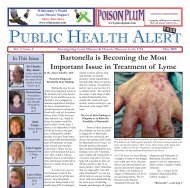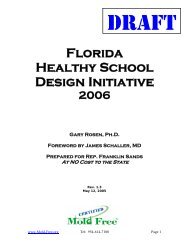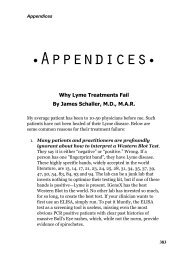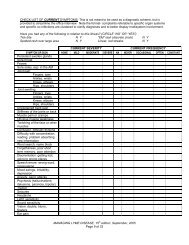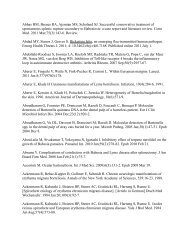Download Here - James L. Schaller, M.D., M.A.R., P.C
Download Here - James L. Schaller, M.D., M.A.R., P.C
Download Here - James L. Schaller, M.D., M.A.R., P.C
Create successful ePaper yourself
Turn your PDF publications into a flip-book with our unique Google optimized e-Paper software.
Environmentally Friendly Mold Remediation Techniques That Significantly Reduce Childhood AsthmaStachybotrys Trichothecene in Yellow RainThe Army had suspected the use of trichothecene as a biologicalwarfare agent in the “yellow rain” attacks in Southeast Asia during theVietnam war. This resulted in a great deal of Army funded researchon trichothecenes and their affect on humans. The research is nowdeclassified and available from the Surgeon General’s office 1 . TheArmy research is important because it discusses studies of mycotoxin(toxins from mold) exposures performed not only on laboratoryanimals, but on humans as well!The Army’s research helps dispel some common myths. The firstmyth is that mold poisoning is a “fad” or scare tactic used by the moldindustry to generate business. The second myth is that mycotoxinsaffect only the respiratory system and that there is no evidence thatmycotoxins affect other parts of the body, such as the human brain.Human Guinea PigsIn the late 1970s and early 1980s, Army research reported that moldtrichothecenes were actually tested on humans! Due to thedebilitating effects of trichothecenes on rapidly proliferating cells,researchers thought the toxins might stall tumor growth. As a result,a test group of cancer patients was given intravenous doses oftrichothecenes. According to army researchers, the patientsexperienced the common symptoms of neurotoxin poisoning: nausea,burning skin, confusion, lack of muscle coordination, slurred speech,and low blood pressure. Testing of trichothecenes as anticancer drugswas abandoned due the life-threatening symptoms and insignificantanti-tumor activity.Much recent work regarding the production of neurotoxic chemicalsby molds has been summarized at the recent conference by theinternational Fungal Research Group 2 .34





